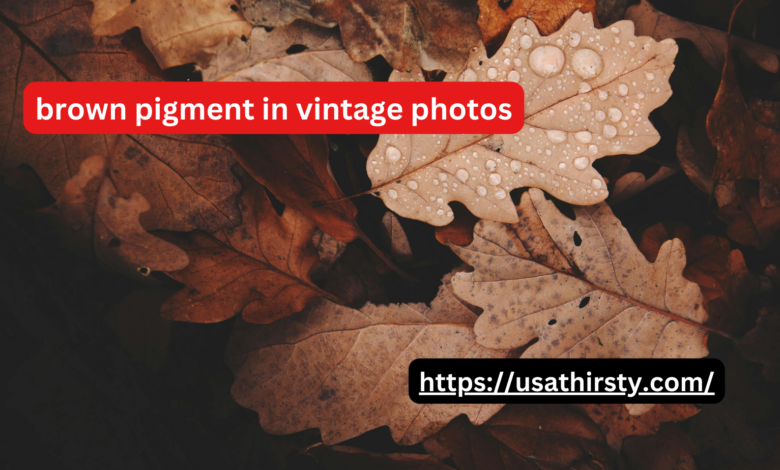Brown Pigment in Vintage Photos: A Nostalgic Appeal and Preservation Challenge

Vintage photos are treasured artifacts, preserving memories, culture, and the aesthetics of bygone eras. One of the defining characteristics of these photos is the warm, brownish tint often seen in old images, which results from the brown pigment in vintage photos. This article explores how this pigment came to be, its importance, and how it has contributed to the unique beauty and sentimental value of vintage photography. We’ll also cover ways to care for and preserve these photos for future generations.
Understanding the Origins of Brown Pigment in Vintage Photos
The brown pigment in vintage photos can be attributed to early photographic processes, such as sepia toning and silver-based emulsions. These processes involved chemicals that added a brown or sepia tone to photos, either intentionally or as a byproduct of aging. In particular, sepia toning, a popular method in the late 19th and early 20th centuries, enhanced image durability while giving photographs a distinct brown hue.
- Sepia Toning: Derived from cuttlefish ink, sepia toning was initially applied to prolong the lifespan of black-and-white photographs. This process replaced the metallic silver in black-and-white images with a more stable compound, creating a warmer and more resilient image. The result was a durable photograph with a deep brown pigment that gave vintage photos their characteristic look.
- Aging Process: Over time, vintage photos naturally develop a brownish tint due to oxidation and the degradation of silver compounds in the photo emulsion. This natural change gives the photos an antique appearance, even if they were not originally sepia-toned.
Why Brown Pigment in Vintage Photos Holds Such Appeal
There’s an undeniable nostalgic allure associated with the brown pigment in vintage photos. The warm tones evoke a sense of history, romance, and timelessness that is hard to replicate in digital photography.
- Historical Significance: The brown pigment serves as a reminder of the limitations and creativity of early photographers. It reflects the materials, techniques, and trends popular during those eras, marking these photos as pieces of cultural history.
- Aesthetic Warmth: Compared to the cooler tones of black-and-white photos, the brownish tint adds depth and warmth, which is why many people find vintage photos aesthetically pleasing. The warmth of the brown pigment can create a sense of comfort and familiarity. Which might be one reason why vintage photography is still appreciat and even imitated today.
The Science Behind Brown Pigment in Vintage Photos
The development of brown pigment in old photographs is a result of chemical reactions that occur within the emulsion of the photograph. Most early photographs were made on a silver nitrate base. Which gradually oxidizes, leading to discoloration. Here’s how this happens:
- Silver Oxidation: Exposure to air and light causes silver particles to oxidize, which alters their color. While newly developed silver-based photos start as black and white, the oxidation process turns them into shades of brown and yellow over time.
- Chemical Degradation: The paper and other materials used in early photographs are prone to acidification. This process leads to discoloration, which often manifests as brownish hues in vintage photos.
- Environmental Factors: Factors such as humidity, light exposure, and temperature changes can accelerate the appearance of brown pigment. Vintage photos stored in poor conditions or frequently exposed to light are especially susceptible to developing a deeper brown tone.
Popular Preservation Techniques to Protect the Brown Pigment in Vintage Photos
Proper preservation is essential for maintaining the brown pigment in vintages photos while also preventing further deterioration. Here are some ways to keep these photos looking their best:
- Controlled Storage Environment: Vintage photos should be stored in a dark, cool, and dry environment to slow the chemical reactions that cause further discoloration.
- Archival Materials: Using acid-free boxes, albums, or sleeves can help protect photographs from further acidification. Acid-free materials prevent the breakdown of photographic chemicals, preserving the natural look and brown pigment in vintageS photos.
- Limited Exposure: Avoid exposing vintage photos to direct sunlight or strong artificial light. Light accelerates oxidation and fading, which can compromise the original brown pigment.
- Digital Backup: Digitally scanning vintage photos allows for their preservation without further handling. While digital copies won’t capture the true texture and warmth of the original brown pigments in vintage photos, they serve as a valuable backup.
Brown Pigment in Vintage Photos vs. Modern Photography
Modern photography relies on digital sensors, eliminating the need for chemical emulsions and pigments. However, there has been a resurgence of interest in vintage aesthetics, with many photographers adding sepia tones or brown filters to replicate the brown pigments in vintage photos. This retro look is often achieve through photo-editing software. But purists argue that the warmth and authenticity of the original chemical processes are unmatched.
- Sepia Filters: Digital filters can mimic the brown tones of vintage photography but lack the depth and historical significance of true sepia-toned images.
- Film Photography: Some modern photographers use film and traditional darkroom techniques to capture images that more closely resemble the warmth and texture of vintage photographs, including the classic brown pigment in vintage photos.
The Lasting Impact of Brown Pigment in Vintage Photos on Photography
The brown pigment in vintage photos has left a lasting legacy on the world of photography. It stands as a testament to the artistry and innovation of early photographers, who worked with limited materials to create enduring images. Today, the sepia and brown hues of vintage photos symbolize nostalgia and timelessness, inspiring both photographers and collectors alike.
Conclusion
The brown pigment in vintage photos is much more than a simple coloration; it’s a combination of history, chemistry, and artistry that has shaped the aesthetics of photography over generations. From the intentional use of sepia tones to the natural aging process, these warm hues are an irreplaceable part of photographic heritage. By understanding the science, history, and preservation methods associated with these photos. We can appreciate them even more deeply and ensure that they continue to be cherish by future generations.

